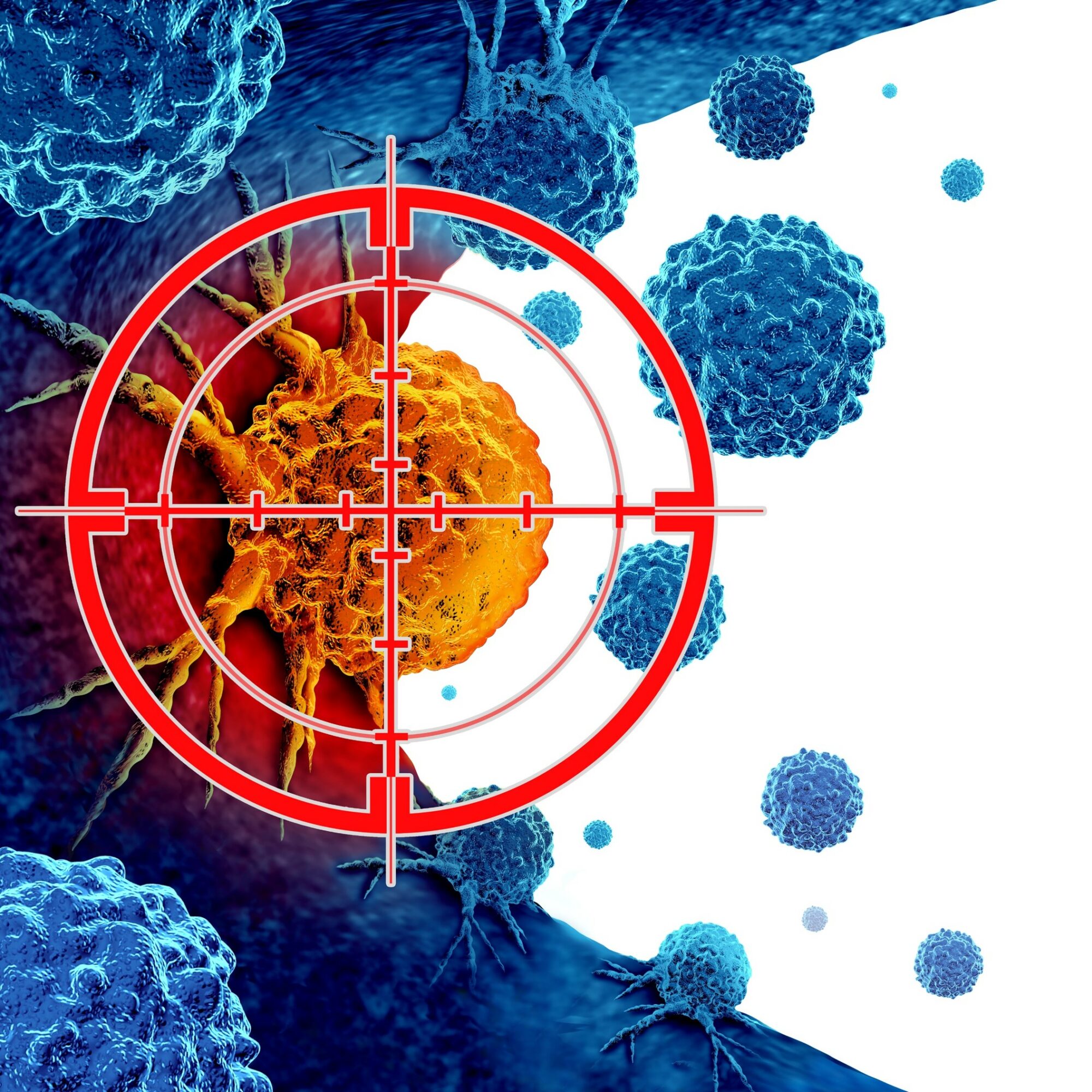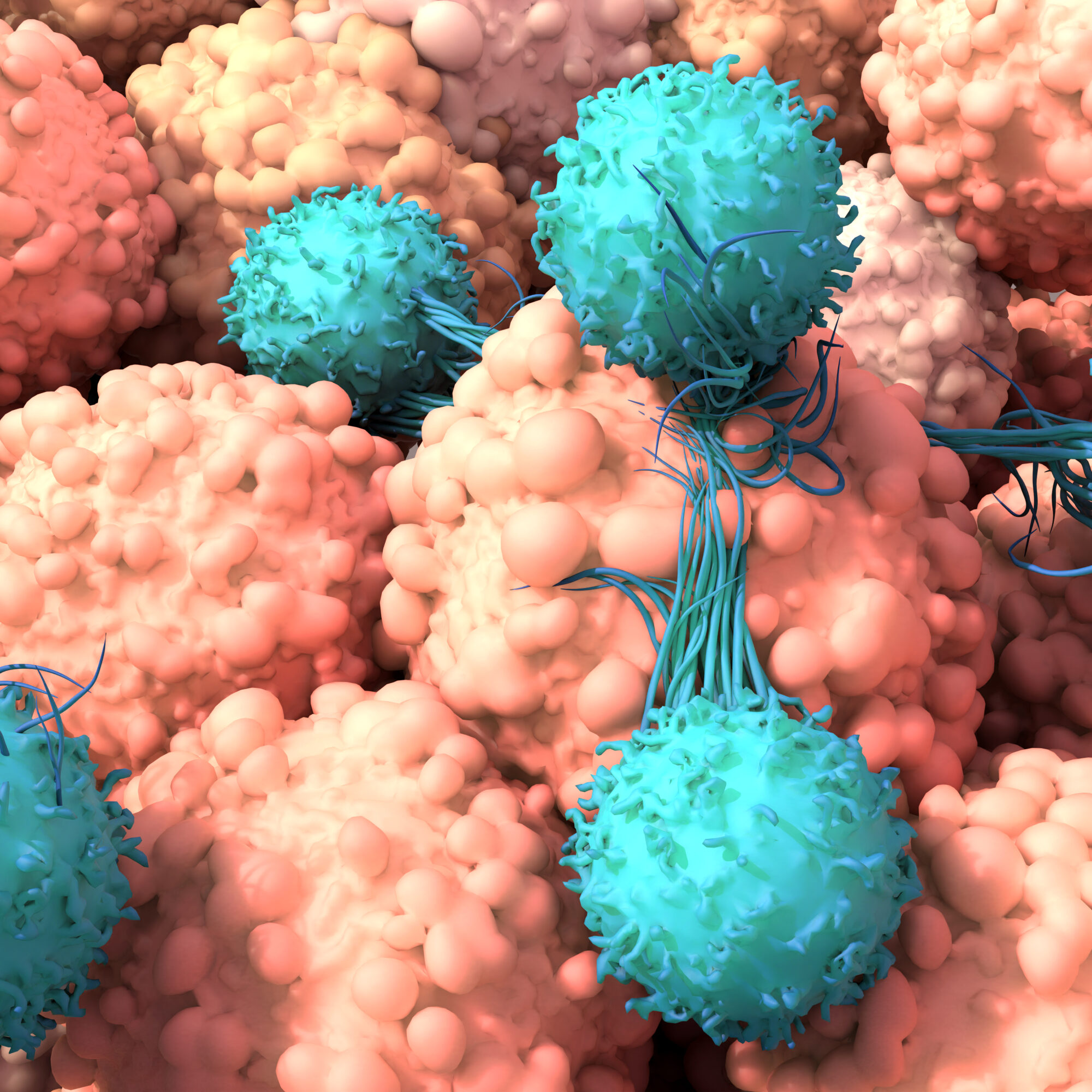Checkpoint inhibitors in cancer immunotherapy
In immuno-oncology, the power of the patient’s immune system is aimed directly to fight tumor cells. However, cancer cells are able to evade the immune response e.g. by interacting with immune cells and inhibiting their attacks. Healthy immune cells are controlling each other’s actions at various checkpoints to prevent an overstimulation of the immune system. Cancer cells take advantage of this self-controlling strategy by mocking or interfering with the signaling of immune cells to block their activity and to escape from the immune response.
In the last years, inhibitors especially against the receptors Cytotoxic T Lymphocyte-Associated Protein 4 (CTLA-4) and Programmed Death-1 receptor (PD-1) or its ligand PD-1L, so called checkpoint inhibitors, were used to treat patients suffering from diverse types of cancer. These inhibitors block the inhibiting pathways used by tumor cells to downregulate the immune response and enable the immune system to strike back.
This immuno-therapeutic approach revolutionized the oncology field, despite the unfortunate fact that the response rate is low in a significant portion of patients. To overcome this limitation, new targets of checkpoint inhibitors are in development that target the tumor cell interaction with other cells of the immune system than only T cells and are already quite successfully tested in clinical trials.
T cell immunoreceptor with Ig and ITIM domains (TIGIT)
TIGIT is a receptor on T and NK cells, which usually binds to the surface molecules CD155 and CD112, that are expressed on tumor antigen presenting cells, to trigger inhibitory signaling to downregulate T or NK cell activity. Tumor cells are also expressing these surface molecules to mimic the physiological control mechanism of the immune system. In this case, tumor cells inhibit the activity of T and NK cells to avoid an immune response aimed at the tumor.
Additionally to binding with TIGIT, CD155 and CD112 could also bind with the surface marker CD226, which is also expressed on T or NK-cells. When CD226 binds to CD155 or CD112 an activating signaling cascade is triggered to stimulate T or NK cells. Thus, blocking of TIGIT binding is not only preventing T cell inhibition, but also allows for T cell activation via CD226 binding. There are different inhibitors in clinical trials to prevent TIGIT binding e.g. MK-7684 (Merck, clinical phase 3), tiragolumab (Roche, clinical phase 3), and AB154 (Arcus Bioscience, clinical phase 3).
The treatment with TIGIT inhibitors showed promising results as shrinkage of tumor size in 30% of non-small cell lung cancer patients (NCT03563716). TIGIT inhibitors are tested as monotherapy as well as in combination with e.g. PD-1 checkpoint inhibitors. Preclinical and first clinical studies suggest that TIGIT inhibition is most effective in tumor suppression when combined with other immunotherapies.
Cluster of differentiation 47 (CD47)
CD47 is a cell surface glycoprotein, which is ubiquitously expressed on human cells and overexpressed on many tumor cells, making it thereby a valuable tumor antigen. Under healthy conditions CD47 binds the surface molecule signal regulatory protein α (SIRPα) on macrophages to trigger an inhibitory signal leading to macrophage downregulation and stop of phagocytosis. The overexpression of CD47 by tumor cells forces macrophages, which actually would attack the tumor cells, to downregulate. Thus, blockage of CD47 could improve immuno-therapy of cancer patients by increasing the number of activated macrophages, which might phagocytose tumor cells.
However in the past, blocking of CD47 led to severe hematological side effects because CD47 is also abundantly expressed on red blood cells. Nowadays, pharmaceutical companies found an ideal risk-benefit profile for their CD47 inhibiting drugs and different monoclonal antibodies are currently in clinical phases to be evaluated for their safety and clinical efficacy, e.g. ALX148 (ALX Oncology, clinical phase 3), magrolimab (Forty-Seven/Gilead, clinical phase 3), lemzoparlimab (I-Mab Biopharma, clinical phase 1).
CD47 inhibitors run in clinical trials as monotherapy and in combination. However, CD47 inhibitors show only moderate response rate when used in monotherapy, but when the therapeutics were tested in combinatorial therapy, a 21% complete response rate could be observed in relapsed and refractory non-Hodgkin lymphoma patients (NCT02953509).
Lymphocyte activation gene-3 (LAG3)
LAG3 is a cell surface protein, which is expressed by activated T cells after antigen stimulation. Usually, the binding of LAG3 with its ligands on antigen-presenting cells triggers an intracellular inhibitory signal leading to deactivation of the specific T cell. This inhibitory stimuli of LAG3 is tightly connected to its expression level. The longer the antigen exposure lasts, the more LAG3 is expressed and the stronger is the inhibitory signaling cascade. Tumor infiltrating T cells are continuously exposed to tumor antigens and strongly express LAG3, which leads to their inhibition.
In various types of cancer, LAG3 expression level and tumor infiltration of LAG3 positive cells are associated with tumor progression, poor prognosis and unfavorable clinical outcome. Blocking the LAG3-ligand binding could reactivate downregulated T-cells and stimulate their anti-tumor functions. Several drugs targeting LAG3 are under investigation, e.g. the antagonistic monoclonal antibodies: Relatlimab (Bristol-Myers Squibb, clinical phase 3), LAG525 (Novartis, clinical phase 2), and MK-4280 (Merck, clinical phase 3).
Only low therapeutic effects could be observed when LAG3 inhibitors were used as monotherapy, but the combination with PD-1 inhibitors increased the therapeutical effect of PD-1 inhibitors alone. The objective response rate was 11% in patients with advanced melanoma, who already failed a previous anti PD-1 or anti-PD-L1 immuno-therapy, after treatment with combined PD-1 and CD47 inhibitors. In patients with LAG3 expression in at least 1% of tumor-associated immune cells within the tumor margin the objective response rate was even higher with 18% (NCT01968109).
To conclude, the three here presented new targets for checkpoint inhibition, reveal the diverse treatment options on cellular level in immuno-oncology. These innovative checkpoint inhibitors target various immune cells and are already tested in late clinical phases. Their therapeutical effects are augmented when they are combined with classical checkpoint inhibitors as PD1 inhibitors. In the future, further investigation of natural checkpoints of the immune system and how tumor cells are able to take advantage out of it, will increase the identification of more targets. Other examples of ongoing approaches in increasing the effect of immuno-therapy in oncology is the use of mRNA based therapeutics or a new generation of CAR T cells, which could also be combined. Of course there are more targets in development, as well as new technologies tested, which are not subject of this article. We at Alcimed will keep you informed about future developments.
About the authors,
Volker, Great Explorer Oncology, and Frederike, Consultant in Alcimed’s Healthcare team in Germany



